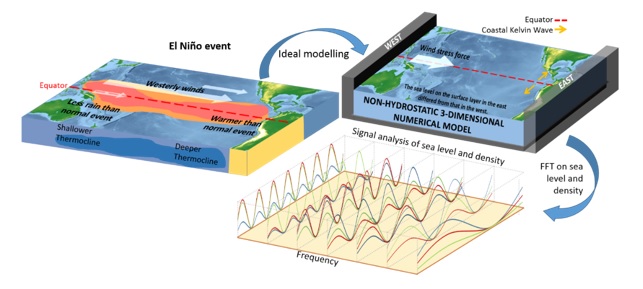Document Type : ORIGINAL RESEARCH ARTICLE
Authors
1 Graduate School of Mathematics and Applied Science, Universitas Syiah Kuala, Banda Aceh 23111, Indonesia
2 Department of Marine Sciences, Faculty of Marine and Fisheries, Universitas Syiah Kuala, Banda Aceh 23111, Indonesia
3 Department of Mathematics, Universitas Syiah Kuala, Banda Aceh 23111, Indonesia
4 Department of Aquaculture, Faculty of Marine and Fisheries, Universitas Syiah Kuala, Banda Aceh 23111, Indonesia
5 Research Center for Marine Sciences and Fisheries, Universitas Syiah Kuala, Banda Aceh 23111, Indonesia
Abstract
BACKGROUND AND OBJECTIVES: El Niño - Southern Oscillation is known to affect the marine and terrestrial environment in Southeast Asia, Australia, northern South America, and southern Africa. There has been much research showing that the effects of El Niño - Southern Oscillation are extensive. In this study, a simulation of an El Niño event is carried out, which is ideal in the vertical layer of the Pacific Ocean (0-250 meters). The fast Fourier transform is used to process the vertical modeling data so that the results can accurately represent El Niño.
METHODS: A non-hydrostatic 3-dimensional numerical model is used in this research. To separate the signal produced and obtain the quantitative difference of each sea layer, the simulation results are analyzed using the fast Fourier transform. Winds blow from the west to the east of the area in perfect El Niño weather, with a reasonably high wind zone near the equator (forming a cosine). Open fields can be found on the north and south sides, while closed fields can be found on the west and east sides. Density is uniform up to a depth of 100 meters, then uniformly increases by 1 kilogram per cubic meter from 100 to 250 meters.
FINDINGS: The results of the model simulation show that one month later (on the 37th day), the current from the west has approached the domain's east side, forming a complete coastal Kelvin wave. The shape of coastal Kelvin waves in the eastern area follows a trend that is similar to the OSCAR Sea Surface Velocity plot data obtained from ERDDAP in the Pacific Ocean in October 2015. In this period, the density at a depth of 0-100 meters is the same, while the density at the depth layer underneath is different.
CONCLUSION: Strong winds could mix water masses up to a depth of 100 meters, implying that during an ideal El Niño, the stratification of the water column is influenced by strong winds. The eastern domain has the highest sea level amplitude, resulting in perfect mixing up to a depth of 100 m, while wind effect is negligible in the lower layers. The first layer (0-50 m) and the second layer (50-100 m) have the same density and occur along the equator, according to FFT. The density is different and much greater in the third layer (100-150 m).
Graphical Abstract
Highlights
- The model simulation made currents from west to east domain by a month and formed a complete coastal Kelvin wave;
- Sea level in the western part is negative around the equator and positive in areas far from the equator;
- Using the FFT on density, wind effects caused the same change pattern in the first layer (0-50 m) and the second layer (50-100 m).
Keywords
- Density
- El Niño-Southern Oscillation (El Niño)
- Pacific Ocean
- Sea level
- The fast Fourier transform (FFT)
Main Subjects
OPEN ACCESS
This article is licensed under a Creative Commons Attribution 4.0 International License, which permits use, sharing, adaptation, distribution and reproduction in any medium or format, as long as you give appropriate credit to the original author(s) and the source, provide a link to the Creative Commons license, and indicate if changes were made. The images or other third party material in this article are included in the article’s Creative Commons license, unless indicated otherwise in a credit line to the material. If material is not included in the article’s Creative Commons license and your intended use is not permitted by statutory regulation or exceeds the permitted use, you will need to obtain permission directly from the copyright holder. To view a copy of this license, visit: http://creativecommons.org/licenses/by/4.0/
Citation Metrics & Captures
Google Scholar | Scopus | Web of Science | PlumX Metrics | Altmetrics | Mendeley |



Letters to Editor
[1] Letters that include statements of statistics, facts, research, or theories should include appropriate references, although more than three are discouraged.
[2] Letters that are personal attacks on an author rather than thoughtful criticism of the author’s ideas will not be considered for publication.
[3] Letters can be no more than 300 words in length.
[4] Letter writers should include a statement at the beginning of the letter stating that it is being submitted either for publication or not.
[5] Anonymous letters will not be considered.
[6] Letter writers must include their city and state of residence or work.
[7] Letters will be edited for clarity and length.
Send comment about this article